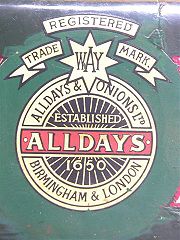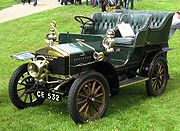
Alldays & Onions
Encyclopedia

England
England is a country that is part of the United Kingdom. It shares land borders with Scotland to the north and Wales to the west; the Irish Sea is to the north west, the Celtic Sea to the south west, with the North Sea to the east and the English Channel to the south separating it from continental...
automobile
Automobile
An automobile, autocar, motor car or car is a wheeled motor vehicle used for transporting passengers, which also carries its own engine or motor...
maker, it manufactured cars from 1898 to 1918. The cars were sold under the Alldays name. The company also built an early British built tractor, the Alldays General Purpose Tractor.
History
The Alldays & Onions Pneumatic Engineering Co. of BirminghamBirmingham
Birmingham is a city and metropolitan borough in the West Midlands of England. It is the most populous British city outside the capital London, with a population of 1,036,900 , and lies at the heart of the West Midlands conurbation, the second most populous urban area in the United Kingdom with a...
, was a company founded in 1889 by the merger of the long established Onions (dating from 1650) and Alldays (dating from 1720) engineering companies. Like many such companies they turned to bicycle manufacture and sold a range under the Alldays name. They also started making motorcycles in 1903 under the Alldays-Matchless name; these had no connection with the London based Matchless
Matchless
Matchless is one of the oldest marques of British motorcycles, manufactured in Plumstead, London, between 1899 and 1966. A wide range of models was produced under the Matchless name, ranging from small two-strokes to 750 cc four-stroke twins...
company, and in 1915 presumably following representations from them, the name was changed to Allon. Manufacture of these continued until 1927.

The company hit commercial success with the 1.6-litre, vertical-twin side-valve 10/12, which was made from 1905 to 1913. It was popular with commercial drivers and did well in period formula events and hill-climbs. A 16 hp 4-cylinder joined the lineup in 1906, and in 1908, the Enfield Autocar Co. was acquired. Shortly afterward, the range was rationalized, with most models being sold under both brand-names. The Alldays contribution to the equation was the well-established twin- and four-cylinders that put out 14 and 20 hp, always shaft-driven. A 30/35 hp six-cylinder was listed from 1911 to 1914, compressed-air starters being optional in 1911. In 1913, the 990 cc V-twin Midget cyclecar was introduced, featuring air cooling and shaft drive, selling at ₤138.10s. An 1100 cc 4-cylinder version with a bullnose radiator appeared in 1914, popular at the price of ₤175. Pair-cast side-valve four-cylinders rated at 12/14, 16/20, and 25/30 hp filled out the immediate pre-war offerings.
Alldays & Onions merged with Enfield, a company they had owned since 1907, and produced cars called Enfield-Allday until 1925.
Main Car Models
| Year | Model | Engine | |
|---|---|---|---|
| 1898–1904 | Traveller | 4 hpDe Dion De Dion-Bouton De Dion-Bouton was a French automobile manufacturer and railcar manufacturer operating from 1883 to 1932. The company was founded by the Marquis Jules-Albert de Dion, Georges Bouton and his brother-in-law Charles Trépardoux.... single 500 cc |
Quadricycle type. Two-seater - passenger in front of driver. Wheel steering. Rear "suspension" unsprung. |
| 1903–1908 | 7 | Flat twin 7 hp | Rear-engined. Four-seater. Although not put into production until 1903 this car had actually been shown at the 1900 National Show. Described as being of "novel construction" with a mixed shaft, gear and belt transmission, combined with great inefficiency. |
| 1903–1907 | 7 and 8 | 6.5 hp single (7hp) and an eight hp single. | Shaft drive |
| 1905–1913 | 10/12 | 1611 cc twin | Three- (early) or four-speed gearbox. Shaft drive. Van version from 1906. |
| 1906 | 16 | 3402 cc pair-cast four-cylinder | |
| 1906–1911 | 20/25 | 3261 cc four-cylinder | |
| 1908-12 | 14/18 | 2500 cc four-cylinder | |
| 1911- | Expressodel | 7/8 hp | Tri-van. Chain drive. |
| 1911-14 | 30/35 | 4891 cc six-cylinder | Compressed air starter from 1911. |
| 1912-16 | 12/14 | 2174 cc four-cylinder | |
| 1912-16 | 16/20 | 3012 cc four-cylinder | |
| 1912-16 | 25/30 | 4082 cc four-cylinder | |
| 1913-14 | Midget | 990 cc V twin | Cyclecar. Van version in 1912. |
| 1914 | 8/10 | 1094 cc four-cylinder | Bullnosed radiator |
Tractor Models
- The Alldays General Purpose Tractor - only a couple of examples survive in the UK of this early internal-combustion-engined model. The tractor had advanced features such as sprung axles, enclosed engine and a basic canopy for the operator.

